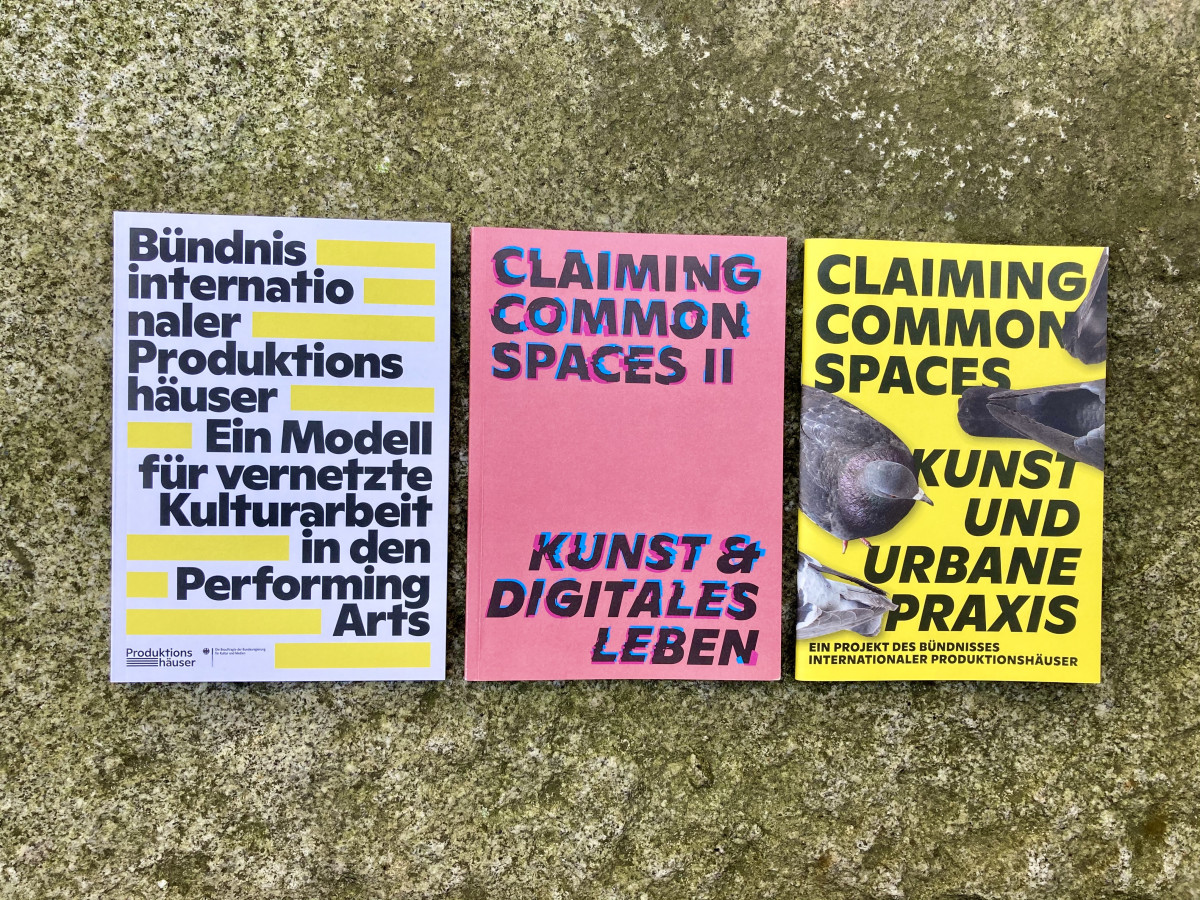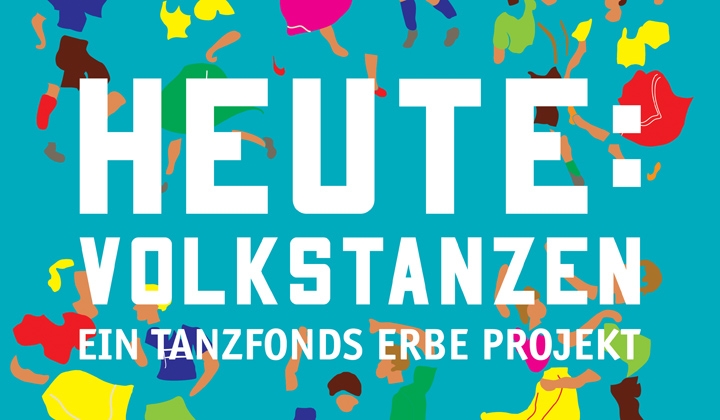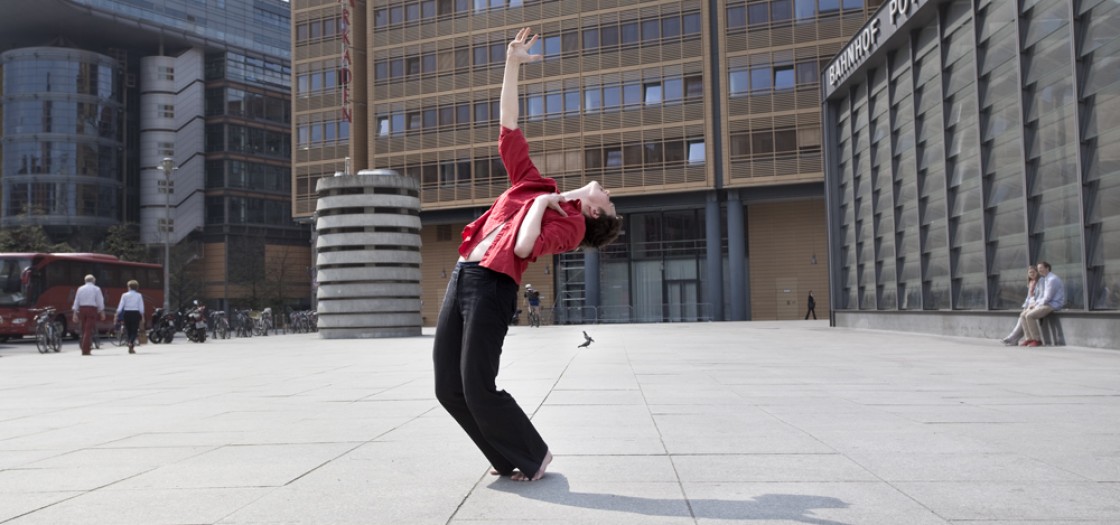Tanzarchiv Leipzig e.V. staff and members are available to advise on artistic projects, from initial ideas for dealing with the cultural heritage of dance to concrete enquiries about more complex research and possible academic advice and dramaturgical support for dance productions. Please send your enquiries about such offers up to project-related cooperations by e-mail to the following address: info@tanzarchiv-leipzig.de.
Below you will find some exemplary projects from recent years in which individual members of the Tanzarchiv Leipzig e.V. were more or less directly involved or which were created in cooperation with TAL e.V..
Tanz Digital (2021)
The Coronavirus crisis forced many theatres, independent groups and artists to rethink their own artistic work and to deal with other aesthetics and forms of presentation. This created countless possibilities to watch dance recordings online, but at the same time the need for specific forms and recording dramaturgies as well as own theatrical and choreographic aesthetics became clear.
Coordinated within the umbrella organisation Tanz Deutschland, the Tanz Digital project responds to these current developments and promotes the emergence of innovative choreographic and artistic formats, testing new recording and production formats – e.g. working with bodycams, 3D and 360° recording techniques, VR and AR applications, streaming and video-on-demand productions, format development for social networks and gaming.
The digital presentation of dance is to be placed in the context of dance history in order to work out interfaces between dance and its media representation. At the same time, audiovisual, photographic and textual documents are to form a context for the current works. For this reason, dance archives have a special role to play in the development of the programme. Together, the network of German dance archives will create the editorial and legal basis for the public presentation of the material.
As part of the project, Tanzarchiv Leipzig e.V. is responsible for the editorial support and the scientific content of the platform. Beneficial to this, is the proximity to the Institute for Theatre Studies at the University of Leipzig. Through thematically adapted courses at the institute, students can thus participate directly in the project in the sense of theory-practice transfer.
In the call for proposals phase of Tanz Digital, artistic and cross-media productions (as artistic adaptations for recording or transmission into digital space) are to be funded. The aim is also to pass on the experience of artists and producers to dance ensembles, theatres and independent dance professionals in workshops and creative mediation formats. Tanz Digital is only the starting point of a long-term work on transmedial dance presentation. In the course of the project, further funding possibilities will be developed.The call for proposals runs until 10 May 2021. Further information and the application for funding can be found here.
Evaluation of the Alliance of International Production Houses (2018, 2020)
Since May 2018, Tanzarchiv Leipzig e.V., together with the CCT and the Institute for Theatre Studies, has been evaluating and advising the Bündnis internationaler Produktionshäuser (BiP) (English: Alliance of International Production Houses). The BiP is an association of seven production houses of the independent theatre scene (Forum Freies Theater e.V., Hebbel-Theater Berlin Gesellschaft mbH, Hellerau – Europäisches Zentrum der KünsteDresden, Kampnagel Internationale Kulturfabrik GmbH, Künstlerhaus Mousonturm Frankfurt am Main GmbH, Choreographisches Zentrum NRW Betriebs-GmbH, Tanzhaus NRW in Düsseldorf). Since May 2016, the BiP has been funded by the Beauftragten der Bundesregierung für Kultur und Medien (BKM) (English: Federal Government Commissioner for Culture and the Media).

Together with its partners, the Tanzarchiv evaluated the work of the alliance for the first time from May to October 2018 and presented the final study on 1 November 2018. This study came to the conclusion that the BiP and its funding offer the opportunity to strengthen advanced models of institutional structure building and networking in artistic, organisational and political as well as financial terms. With additional projects and the cooperation of the alliance partners as a whole, a new form of coordination of both content-related objectives and communication processes, workflows and administrative routines in the independent scene is emerging. This was followed by an accompanying consultation of the alliance and its partners in 2019. In May 2020, the team Tanzarchiv, CCT and Institute for Theatre Studies was again commissioned to evaluate the alliance.
Ernest Berk: The Complete Expressionist (2018)
The production by Berlin choreographer Christoph Winkler, funded by the Tanzfonds Erbe, recalled the life and work of the dancer, choreographer, dance therapist and educator Ernest Berk, who was also a pioneer of electronic music in England from the 1950s. At the end of the 1920s, Berk, who came from Cologne, had studied expressive dance with his future wife Lotte Berk under the Brazilian Wigman student Chinita Ullmann before emigrating to England in 1933.
For the project, many of Berk’s students and employees were interviewed, and on the other hand, the various materials and media that still exist on Berk’s musical work were used. Based on the combination of these sources and information, Christoph Winkler developed a reconstruction of some of Berk’s choreographic works with a selection of his sampling pieces and electronic compositions as well as live music by group A, Rashad Becker and Pan Daijing together with an international ensemble formed for this purpose (dance: Gareth Okan, Emma Daniel, Martin Hansen, Lois Alexander, Riccardo De Simone, Sarina Egan-Sitinjak, Julia B. Laperrière, Dana Pajarillaga, Luke Divall, Lisa Rykena).The production dramaturge was Elena Polzer, the academic advisor Prof. Dr Patrick Primavesi, who gave an introductory lecture at the premiere at the ctm-Festival at the HAU in Berlin in January 2018 and at the revival of the production in early September 2019 at the Akademie der Künste, Berlin.
Slave to the rhythm (2018)
In the context of the Lebensreform (English: life reform) movement, the Swiss composer and music educator Émile Jaques-Dalcroze founded rhythmic-musical education at the beginning of the 20th century as a method of presenting music physically. This approach was part of a comprehensive social design in search of the new human, a social utopian and at the same time artistic experiment that attracted and enthused an international audience, especially in the garden city of Hellerau and the festival theatre designed by Heinrich Tessenow, Adolphe Appia and Heinrich Salzmann.

Hermann Heisig’s project Slave to the rhythm (developed and performed together with Elpida Orfanidou, Pieter Ampe, Jessica Batut, Alma Toaspern) was an attempt at a physical approach to Dalcrozes’ method of rhythmic gymnastics in order to examine its utopian potential from today’s perspective. Accompanied by a Korg Poly 800 synthesizer and music by Kassem Mosse, a landscape of intertwined rhythmic constellations emerged, an absurd course, with playful means and not always entirely serious.
The project was a co-production with HELLERAU – European Centre for the Arts Dresden, funded by the Performing Arts Fund and the Cultural Foundation of the Free State of Saxony. For research and conception, the team was academically advised by Prof. Dr Patrick Primavesi, with whom an audience discussion also took place at the premiere.
Villa Wigman. Bautzner Straße 107. Past Present Future (2017/2018)
At Mary Wigman’s long-time place of work and life, the project funded by the TANZFONDS ERBE with the performance title Kreis Dreieck Chaos (English: circle triangle chaos) by Anna Till, Katja Erfurth, Johanna Roggan and Isaac Spencer aimed overall to open up new perspectives of use for the building of the former Wigman School in dialogue with the historical dimension of the site.
In the first part of the project, a workshop lasting several days was held at the end of June 2017, in which very different approaches to Mary Wigman and the tradition of modern expressive dance she founded in Germany were developed, in cooperation with Tanzarchiv Leipzig e.V., the Hochschule für Musik und Darstellende Kunst Frankfurt/Main, the Hochschule für Bildende Künste Dresden, the Institute for Theatre Studies at the University of Leipzig, the Dachverband Tanz Deutschland and TENZA. In combination with master classes by the dancers Susanne Linke and Irene Sieben, who were still trained by Wigman, and a workshop on the development of the Wigman School in Dresden (with students from Dresden, Leipzig and Frankfurt am Main), work was done in each case on linking the present and the past.
The second phase of the project led to four performances by the participating choreographers at the Societaetstheater in Dresden in mid-September 2017, showing very different updates of the dance impulses emanating from Wigman and thus also putting the future of this tradition up for discussion. With its three time levels, this project of the Villa Wigman für TANZ e.V. association was an important step on the way to preserving the former workplace of the dancer and choreographer Mary Wigman.The former school building has since been acquired by the city of Dresden and made available to the Villa Wigman für TANZ e.V. association with a leasehold contract. Since then, with the help of TANZPAKT Stadt-Land-Bund and other partners, this culturally and historically significant location can be used as a rehearsal, production and mediation centre for contemporary dance (as well as theatre and performance). Currently, extensive work is also being carried out to properly renovate and repair the building.
TODAY: FOLK DANCING (2013)
As part of the Tanzarchiv Leipzig e.V.‘s cooperation with the K3 Centre for Choreography in Hamburg and the Schaubühne Lindenfels in Leipzig, funded by the Tanzfonds Erbe, the four choreographers Jenny Beyer, Heike Hennig, Isabelle Schad and Doris Uhlich were invited to examine folk dance, participation and involvement from today’s perspective. In a preparatory phase, the choreographers researched Tanzarchiv Leipzig with its folk-dance holdings that are unique in Germany.

The results of this choreographic research were brought together in workshops and pitches, reflected on together and presented in the context of a folk-dance festival on a total of 5 event evenings in Hamburg and Leipzig. At the opening of each of these dance festivals, a workshop was held in which experts taught interested participants some basic steps and figures from traditional folk dances.This was also accompanied by a symposium with experts and an exhibition with posters, films and other materials on the diversity of folk dance as a cultural practice. From Tanzarchiv Leipzig e.V., Dr Theresa Jacobs, Juliane Raschel and Prof. Dr Patrick Primavesi were involved in this production through scientific and conceptual advice.
PAX 2013: Blooming Landscape and Pax Questuosa (2013)
The double evening PAX 2013 by the Leipzig Ballet under the direction of Mario Schröder combined the choreography Pax Questuosa (the doubtful peace) by Uwe Scholz, which was created in 1992 and has been revived several times since, with the new production Blühende Landschaft by Mario Schröder. The basis for this production were compositions by Udo Zimmermann and Johann Sebastian Bach, which had already clashed in the large oratorio Pax Questuosa when dealing with the ongoing wars of the present.

Blühende Landschaft began with a look back at the early 1990s and the promises of capitalist redevelopment of the “new”, eastern federal states, which have only been partially fulfilled to this day. The question of arriving in a foreign environment, which is still acute for the Leipzig Ballet company consisting of over 25 nationalities, led to contemporary perspectives on dealing with the past, tradition and cultural memory in an increasingly globalised and digitalised present.
This production was also funded by the Tanzfonds Erbe of the German Federal Cultural Foundation, which made possible in particular the major effort to reconstruct Scholz’s Pax Questuosa choreography at the Leipzig Opera House. A wide range of materials and documents from the Scholz estate in the Tanzarchiv Leipzig and on the crisis-ridden contexts of the creation of this work during the post-reunification period in Leipzig served as sources for the overall project.
The new production of Pax Questuosa was choreologically supported by Tatjana Thierbach, and the academic supervision and dramaturgy for the PAX 2013 project was provided by Prof. Dr Patrick Primavesi. In the 2019/20 season, Blühende Landschaft was revived, now combined with a new production of Henrik M. Górecki’s Sinfonie der Klagelieder (English: Symphony of Lamentations) as part of Lamento.
Jean Weidt – Physical Encounters (2013)
The almost forgotten “red dancer” Jean Weidt (1904-1988) was driven by communist convictions and obsessed with dance. At the centre of his choreographic works was the unequivocal representation of political content through exemplary narratives. For Physical Encounters, Angelika Thiele, Maria Walser and Britta Wirthmüller have appropriated Weidt’s physicality and propagandistic aesthetics: Physical tension, rhythmic movement phrases and concrete movement sequences from the working class world of the early 20th century irritate our gaze, which is accustomed to physical efficiency and abstract representation. Their bodies become the site of an encounter that seems inappropriate to us, negotiating and thus mixing opposites such as past and present, female and male, the familiar and the foreign.

The concept by Britta Wirthmüller and her dramaturge Jessica Buchholz was realised in dance and choreography with Maria Walser and Angelika Thiele, in cooperation with Tanzfabrik Berlin and Lofft TheaterLeipzig. The production was academically advised by the Tanzarchiv Leipzig, funded by the Hauptstadtkulturfonds and the Kulturstiftung des Freistaates Sachsen, supported by the Hochschulübergreifendes Zentrum Tanz Berlin.
LIGNA: Dance of All – A Movement Choir (2010/2013)
The dance performance, Dance of All – dealt with the neglected legacy of the movement choirs that manifested dance as a social phenomenon and political practice in the 1920s and early 30s. Initiated by Rudolf von Laban, dancing together in a movement choir enabled amateur groups in the Weimar Republic to discover movements beyond their everyday work. Thus, as a chorally organised mass, they could also perform in front of an audience and present utopian designs of a different, future society.
The LIGNA project was not merely a re-enactment of the amateur choirs, but rather an update of the aesthetic and political questions that once emanated from the movement choirs. As in other LIGNA works with the radio ballet format, the boundary between actors and spectators was removed: With the help of headphones or earphones and small radio receivers, all participants were able to take part in the choreography and appropriate its movement material.The project was developed in cooperation with the research project Bewegungschöre: Körperpolitik im modernen Tanz (English: Movement Choirs: Body Politics in Modern Dance) by Prof. Dr Patrick Primavesi, for which a joint publication is being published by spector books. It contains written sources and photos of the movement choirs, as well as research contributions and the text of the piece Tanz aller –. An earlier version of this movement choir work has already been presented at the festival play! LEIPZIG. Bewegung im Stadtraum (2010).
